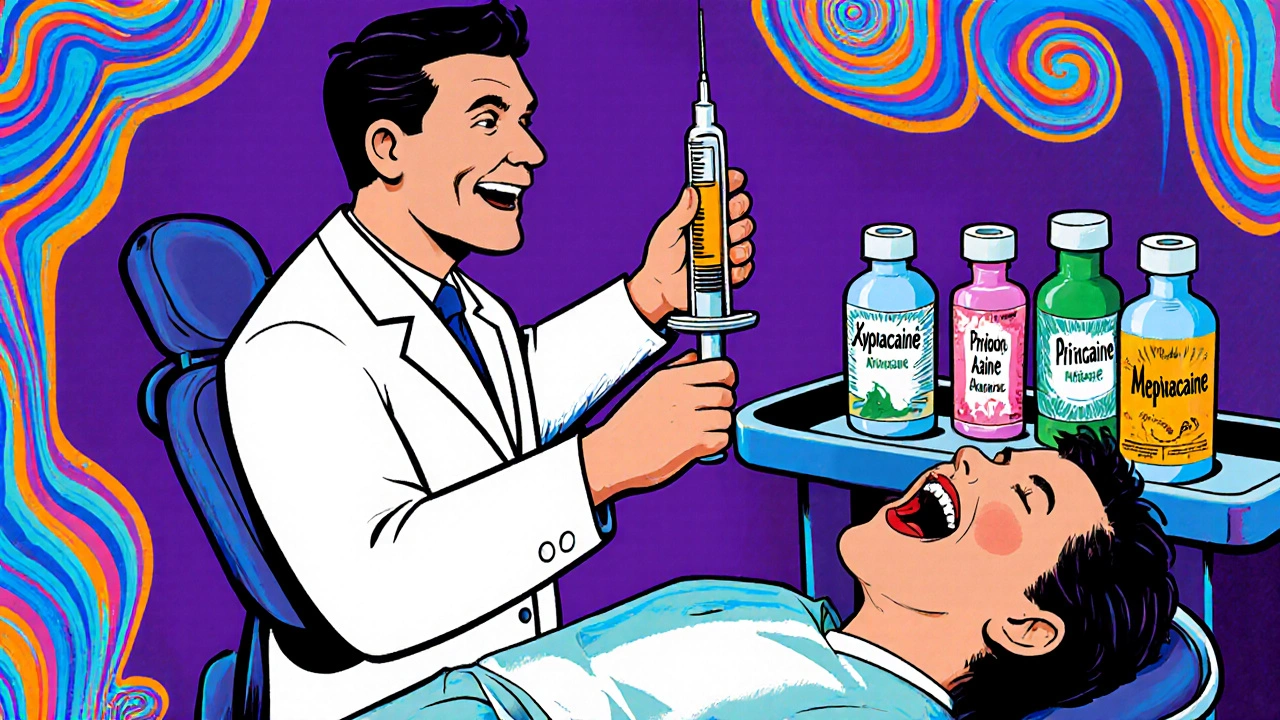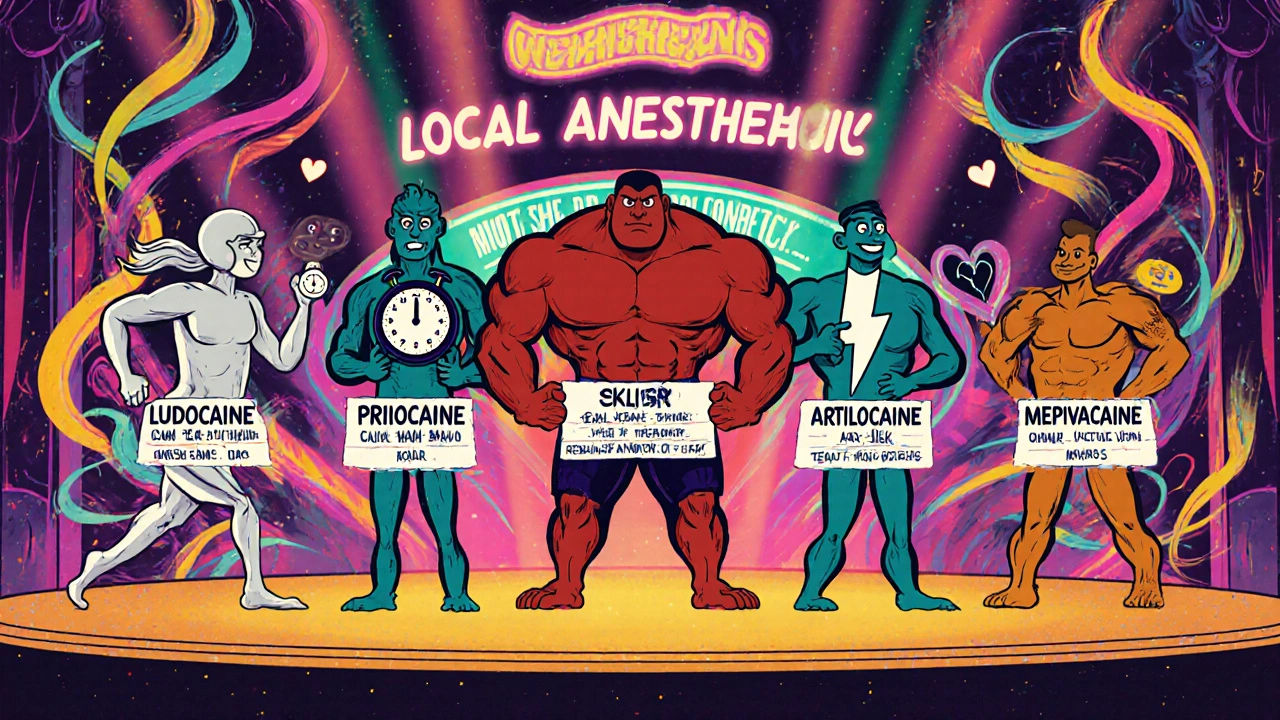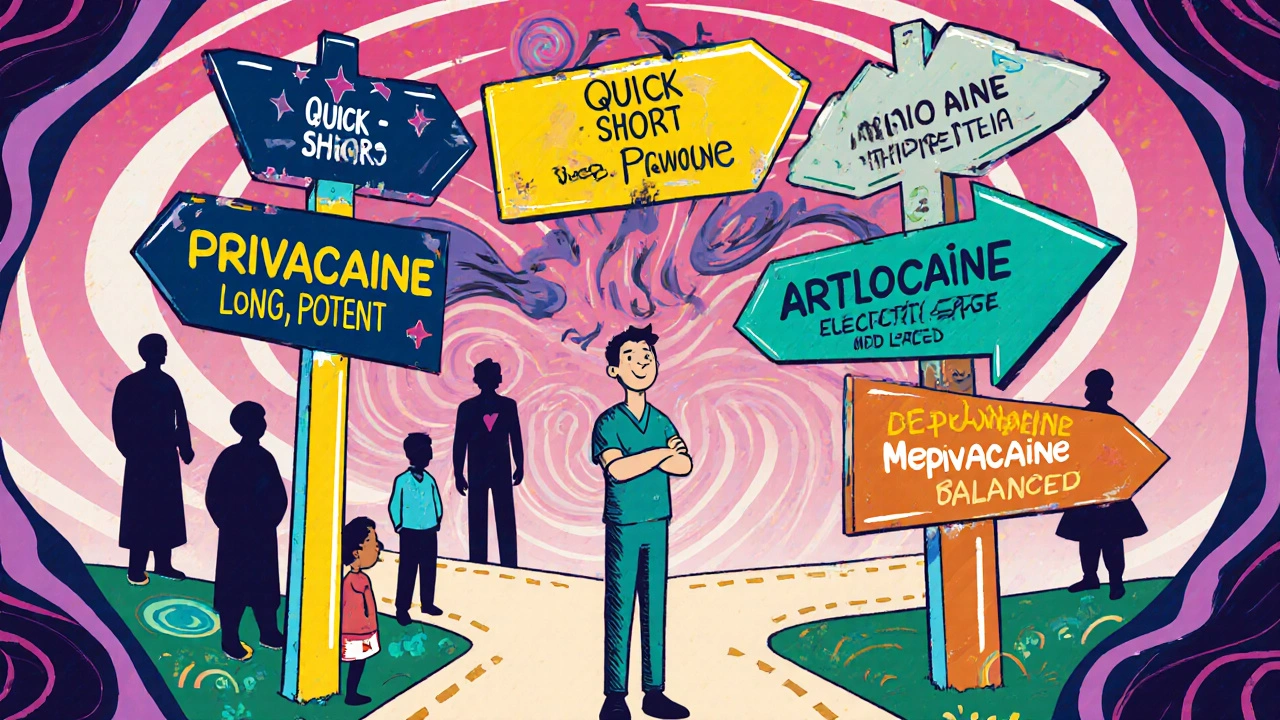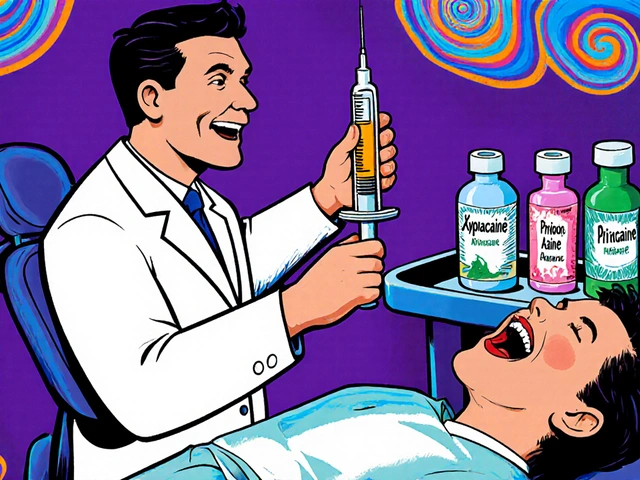
Local Anesthetic Dose Calculator
Enter patient weight and select an anesthetic to see maximum safe dose.
When a dentist numbs a tooth or a surgeon preps skin for a stitch, the choice of local anesthetic can change the whole experience. Xylocaine is the brand name for lidocaine, a widely used amide‑type local anesthetic that offers rapid onset and moderate duration. It’s the go‑to for many dental and minor surgical procedures, but it isn’t the only option on the shelf. Below you’ll find a side‑by‑side look at lidocaine and its most common alternatives, so you can see which agent fits the procedure, the patient, and the safety profile you need.
Why the Choice Matters
Local anesthetics differ in four practical dimensions:
- Onset time - how quickly the numbness starts.
- Duration - how long the effect lasts before sensation returns.
- Potency - the strength of nerve block per milligram.
- Safety window - maximum recommended dose and risk of systemic toxicity.
Patients also care about side effects like tingling, heart rhythm changes, or prolonged numbness. Clinicians weigh those risks against how well the drug performs for the specific tissue (skin, mucosa, bone) and whether they need adjuncts such as epinephrine.
Key Players in the Marketplace
All agents discussed belong to the amide class, which is generally more stable than ester anesthetics and preferred for longer procedures. The table below captures the core numbers most practitioners use when comparing drugs.
| Agent | Onset (min) | Duration (h) | Potency* (relative to lidocaine) | Max Dose (mg/kg) | Typical Use |
|---|---|---|---|---|---|
| Lidocaine (Xylocaine) | 2‑5 | 1‑2 | 1.0 | 7 | Dental infiltration, minor skin procedures |
| Bupivacaine | 5‑10 | 4‑8 | 4‑5 | 2 | Orthopedic blocks, long‑lasting postoperative analgesia |
| Prilocaine | 3‑6 | 1‑2 | 0.8 | 6 | Dental infiltration, peripheral nerve blocks where methemoglobinemia risk is low |
| Articaine | 1‑3 | 1‑2 | 1.5 | 7 | Dental procedures needing deep bone penetration |
| Mepivacaine | 2‑4 | 2‑3 | 1.2 | 4.5 | Oral surgery, situations where vasoconstrictor is avoided |
Deep Dive into Each Agent
Lidocaine (Xylocaine)
Because it’s fast‑acting and relatively safe, lidocaine dominates the dental market. A 2 % solution without epinephrine usually starts working in under three minutes, and the effect lasts about 90 minutes. Adding epinephrine (1:100,000) can stretch the duration to two hours and cut systemic absorption, which is handy for longer extractions. The drug is metabolized by the liver enzyme CYP2D6, so most patients tolerate it well. Key pros:
- Rapid onset - ideal for quick procedures.
- Well‑studied safety profile.
- Compatible with most vasoconstrictors.
- Short duration compared with bupivacaine.
- Maximum dose of 7 mg/kg can be limiting for extensive blocks.
Bupivacaine
Bupivacaine is the heavyweight champion of duration. A 0.5 % solution can keep a patient numb for up to eight hours, making it the favorite for postoperative pain control after orthopedic surgery. Its downside is a slower onset (5‑10 minutes) and a tighter safety margin - the max dose drops to just 2 mg/kg because cardiac toxicity is a real concern. Key pros:
- Longest duration among commonly used amides.
- High potency; smaller volumes achieve the same block.
- Slow onset - not great for short, bite‑size work.
- Higher risk of cardiotoxicity; requires careful monitoring.
Prilocaine
Prilocaine shines when you want a lidocaine‑like profile but need to avoid epinephrine‑related hypertension. Its onset mirrors lidocaine, yet it carries a unique warning: high doses (above 6 mg/kg) can trigger methemoglobinemia, especially in infants or patients with G6PD deficiency. For adult dental work, the risk is minimal if you stay within dosing limits. Key pros:
- Similar onset to lidocaine with less vasoconstrictor reliance.
- Lower cardiac toxicity than bupivacaine.
- Methemoglobinemia potential at higher doses.
- Potency slightly lower than lidocaine.
Articaine
Articaine is the only amide anesthetic that also contains a thiophene ring, giving it enhanced lipid solubility. The result is a faster onset (often under two minutes) and a modest boost in potency (about 1.5 × lidocaine). It’s popular in Europe for deep dental infiltrations, especially in dense mandibular bone. However, some studies link articaine to a slightly higher incidence of paresthesia when used for mandibular blocks, so clinicians weigh that risk. Key pros:
- Very rapid onset - great for impatient patients.
- High potency helps with dense bone.
- Potential for nerve injury in mandibular blocks.
- Limited FDA approval in the U.S. (used mainly in dental formulations).
Mepivacaine
Mepivacaine offers a middle ground: onset close to lidocaine, duration a notch longer (2‑3 hours), and it works well without a vasoconstrictor. That makes it useful for patients who can’t tolerate epinephrine, such as those with certain cardiac conditions. Its max dose of 4.5 mg/kg sits between lidocaine and bupivacaine, giving a comfortable safety buffer. Key pros:
- Effective without vasoconstrictor.
- Longer duration than lidocaine, shorter than bupivacaine - a balanced choice.
- Not as potent as articaine or bupivacaine.
- May still cause mild cardiovascular effects at high doses.

How to Pick the Right Agent for a Specific Situation
- Assess procedure length. For under‑30‑minute work, lidocaine or articaine gives quick relief. For surgeries expected to last several hours, bupivacaine is worth the slower start.
- Consider patient comorbidities. If the patient has cardiac arrhythmias, avoid bupivacaine’s high cardiotoxic potential. If they have a history of methemoglobinemia, stay away from high‑dose prilocaine.
- Check need for vasoconstriction. Epinephrine‑free solutions (mepivacaine, prilocaine) are safer for hypertensive patients.
- Mind the site. Dense mandibular bone benefits from articaine’s lipid solubility; superficial soft‑tissue blocks work fine with lidocaine.
- Calculate maximal safe dose. Add up all local anesthetic administered during the session. Exceeding the mg/kg limit raises the risk of systemic toxicity - symptoms range from tinnitus and metallic taste to seizures.
Following these steps helps you avoid common pitfalls like prolonged numbness or unexpected heart rhythm changes.
Common Pitfalls and How to Avoid Them
- Mixing agents without accounting for cumulative dose. If you give both lidocaine with epinephrine and a later bupivacaine injection, add the milligram amounts together - the total must stay under the lowest max dose (usually bupivacaine’s 2 mg/kg).
- Ignoring patient age. Children under 12 kg have a much lower safe ceiling; many clinicians switch to a diluted lidocaine (1 %) or choose mepivacaine without epinephrine.
- Over‑relying on vasoconstrictor to extend duration. Epinephrine boosts lidocaine’s window but does not replace a truly long‑acting drug when you need postoperative analgesia for 12 hours.
- Failure to monitor for toxicity. Watch for early signs - circumoral tingling, ringing in ears, confusion - and be ready with an IV lipid emulsion rescue protocol for severe cases.

Quick Reference Cheat Sheet
| Agent | Best For | Avoid If |
|---|---|---|
| Lidocaine | Short‑to‑medium dental work, quick skin biopsies | Need >2 h analgesia, cardiac toxicity risk |
| Bupivacaine | Orthopedic blocks, long‑lasting postoperative pain | Patients with arrhythmias or low cardiac reserve |
| Prilocaine | Dental work where epinephrine is contraindicated | Infants, high‑dose scenarios (methemoglobinemia risk) |
| Articaine | Deep mandibular infiltrations, fast‑onset needs | Patients with known paresthesia susceptibility |
| Mepivacaine | Procedures requiring no vasoconstrictor, moderate duration | When maximum potency is needed |
Frequently Asked Questions
Can I mix lidocaine with bupivacaine in the same procedure?
Yes, mixed solutions are sometimes used to combine rapid onset (lidocaine) with long duration (bupivacaine). However, you must calculate the total milligram amount and stay below the lower of the two maximum dose limits. Many clinicians keep the bupivacaine proportion under 0.25 % to stay safe.
Is articaine safer than lidocaine for patients with hypertension?
Articaine itself does not contain epinephrine, but most dental formulations pair it with a vasoconstrictor. If you choose an epinephrine‑free articaine solution, it’s comparable to lidocaine in cardiovascular safety. The rapid onset can actually reduce the total amount needed, which may be a modest advantage.
What signs indicate local anesthetic systemic toxicity (LAST)?
Early signs include a metallic taste, ringing in the ears, and facial tingling. As toxicity progresses, you may see dizziness, tremor, seizures, or cardiac arrhythmias. Immediate treatment involves securing the airway, seizure control, and administering an IV lipid emulsion.
Why is the maximum dose of bupivacaine so low compared to lidocaine?
Bupivacaine is more lipophilic and stays in nerve tissue longer, but that also means it accumulates in cardiac tissue, raising the risk of ventricular arrhythmias. The low 2 mg/kg ceiling reflects the narrow therapeutic window.
Can I use lidocaine for a pediatric dental extraction?
Yes, but dose‑adjust based on weight. A typical pediatric dose is 4 mg/kg without epinephrine. Always calculate the total amount you’ll give, and consider a buffered lidocaine (added sodium bicarbonate) to reduce injection pain.


The pharmacokinetic profile of lidocaine warrants a nuanced appreciation of its rapid membrane penetration, which stems from its moderate lipophilicity and basic pKa.
Its onset of 2–5 minutes is facilitated by the high proportion of unionized molecules at physiological pH.
Duration, however, is capped at approximately two hours in the absence of vasoconstrictors, a limitation that guides its preferential use in brief oral procedures.
When epinephrine is co‑administered, the half‑life is extended by reducing systemic clearance, thereby achieving a clinically useful two‑hour window.
Compared with bupivacaine, lidocaine’s therapeutic index is broader, allowing a maximal dose of 7 mg·kg⁻¹ without precipitating cardiotoxic sequelae.
Bupivacaine, by contrast, exhibits a markedly lower ceiling of 2 mg·kg⁻¹ precisely because its lipophilic nature predisposes it to accumulate in myocardial tissue.
The relative potency of the agents is reflected in the dose‑response curves: bupivacaine’s potency factor of 4–5 versus lidocaine establishes it as the agent of choice when prolonged analgesia is required.
Nevertheless, the slower onset of bupivacaine (5–10 min) imposes a trade‑off that can be mitigated by an initial lidocaine bolus, a technique that merges rapid anesthesia with extended coverage.
Prilocaine offers an intermediate safety profile, lacking significant epinephrine‑induced hypertension but introducing a dose‑dependent risk of methemoglobinemia, particularly in susceptible pediatric populations.
Articaine’s thiophene ring confers enhanced lipid solubility, accounting for its 1–3 min onset and modestly increased potency (≈1.5× lidocaine).
Clinical observations have linked articaine to a higher incidence of paresthesia in mandibular blocks, a factor that must be weighed against its rapid onset in dense bone.
Mepivacaine occupies a middle ground, providing a 2–4 min onset and a 2–3 h duration without a vasoconstrictor, rendering it suitable for patients with contraindications to epinephrine.
Ultimately, the selection algorithm must integrate procedural duration, patient comorbidities, and the pharmacodynamic ceiling to avoid local anesthetic systemic toxicity (LAST).
Calculating cumulative milligram exposure is imperative, especially when mixing agents; the total dose must remain beneath the lowest individual maximum.
Early recognition of LAST-metallic taste, circumoral tingling, seizure activity-permits rapid intervention with lipid emulsion therapy.
In summary, lidocaine remains the workhorse for short‑duration dental work, but a thorough grasp of the comparative pharmacology empowers clinicians to tailor anesthetic choice to each clinical scenario.
Totally agree that mixing a quick lidocaine start with a bupivacaine tail can give you the best of both worlds 😊.
The key is to keep the total mg/kg under the lowest ceiling, usually the bupivacaine limit.
I’ve seen it work great for outpatient ortho cases where patients need numbness for a few hours but don’t want a long recovery.
Just remember to label the syringes clearly so you don’t accidentally double‑dose! 🚀
Great quick guide, very helpful!
When you’re stuck in a marathon surgery and the lidocaine wears off, the panic really sets in.
It’s like watching the clock tick faster while the patient starts to feel every stitch.
That’s why having a bupivacaine backup is a lifesaver – it buys you those extra precious hours.
Just don’t forget the cardiotoxic warning; it’s a fine line between comfort and danger.
Stay cool, calculate the dose, and trust the pharmacology.
Listen up, folks – the max dose limits are non‑negotiable.
For lidocaine you can’t exceed 7 mg per kilogram, and for bupivacaine it drops dramatically to 2 mg/kg because of its cardiac profile.
If you’re mixing agents, add every milligram together and stay under the lowest threshold.
Remember to adjust for epinephrine – it lets you stretch lidocaine’s duration without upping the total systemic load.
For pediatric cases, drop the concentration to 1 % and keep the total under 4 mg/kg to avoid toxicity.
Always have a lipid emulsion kit on hand; it’s the rescue antidote for LAST.
These safeguards keep the patient safe and the procedure smooth.
Nice rundown – the table makes it easy to spot which drug fits a given scenario.
I’ve found articaine’s rapid onset a lifesaver for tight mandibular blocks, but I keep an eye on the paresthesia reports.
Overall, matching the drug to the procedure length and patient health is the sweet spot.
It’s baffling that some clinicians still reach for lidocaine on a full‑day orthopedic case.
That’s a textbook example of ignoring pharmacodynamics and putting patients at risk for breakthrough pain.
Switch to bupivacaine or add a long‑acting adjunct – it’s not rocket science.
Patient safety should trump habit.
Honestly this guide is overcomplicated.
Most docs just use lidocaine and call it a day – why all the fancy tables?
People need simple rules, not a chemist degree.
You could condense this into a one‑page cheat sheet.
Less is more, in my opinion.
LAST threshold = Σ(mg of each agent) ≤ min{max_dose_agent} × weight_kg.
Immediate lipid emulsion therapy lowers plasma free fraction.
The pharmacodynamic interplay between lidocaine and epinephrine is often underappreciated.
EpR constricts local vasculature, thereby decreasing systemic absorption and extending effective duration.
Neglecting this can lead to premature return of sensation and patient discomfort.
Incorporate this principle when planning for postoperative analgesia.
Love how clear this is – super useful! 🌟
Good point on the dosing calculations, Jai.
Just to add, when you’re near the lidocaine ceiling, consider buffering with sodium bicarbonate – it reduces injection pain and can shave a few seconds off the onset.